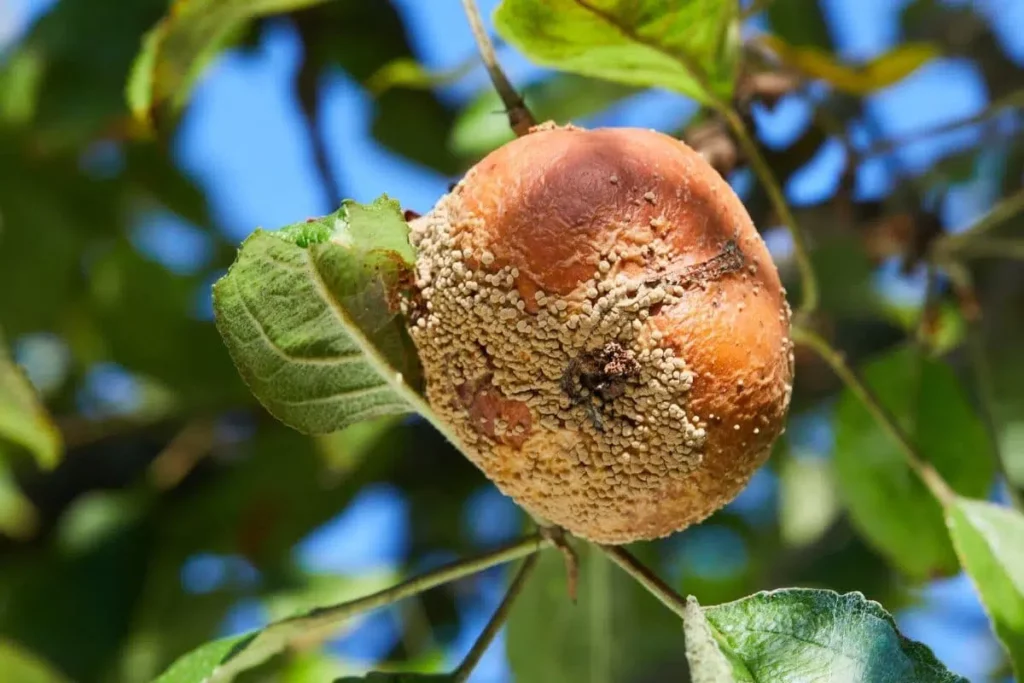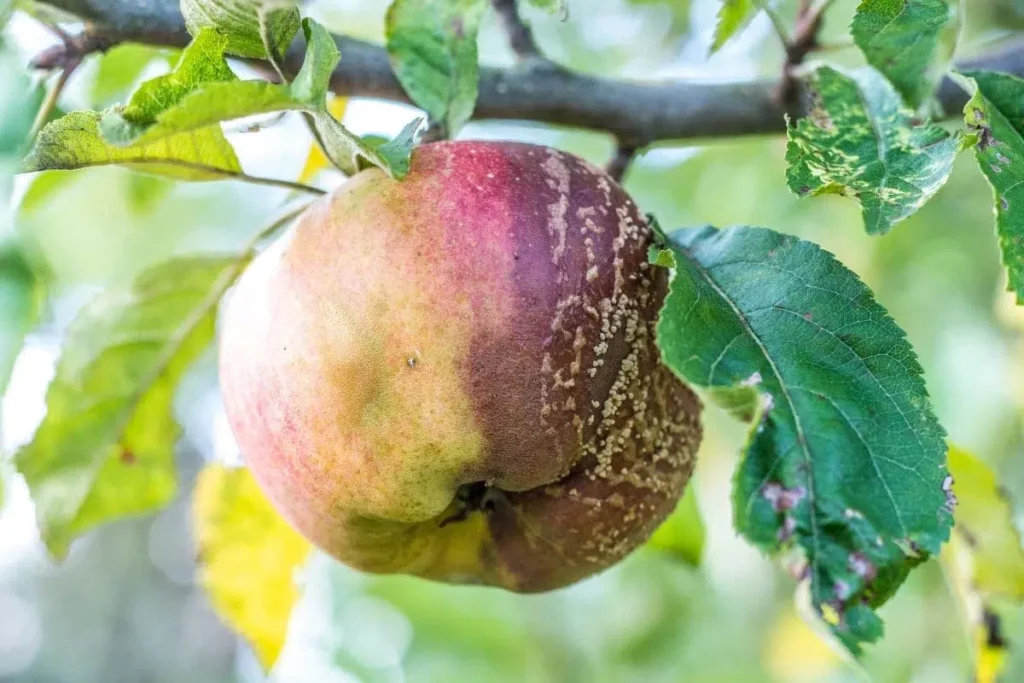If an apple tree (Malus domestica) has rotting apples, this can spread throughout the fruit crop and neighboring fruit trees. Find out now what to do about it.
- several triggers for rotten apples on the tree possible
- fruit rot mostly caused by fungi
- fast action required
Contents
- 1 Detect rotten apples
- 2 Monilia rot
- 3 What to do?
- 4 Triggers and control
- 5 Frequently asked questions
- 6 Can apple powdery mildew also be responsible for rotting apples?
- 7 What role does the location play in relation to apple blight?
- 8 Are there apple trees that are particularly susceptible to Monilia blight?
- 9 Author
Detect rotten apples
Apples go through various changes during their ripening development and can show different defects. These range from mushy to differences in size and color. Not every discoloration or softer consistency immediately suggests rot. This can be identified by very typical characteristics:
- brown spots, which increase in size with time
- fruit skin lesions are usually visible
- under brown spots first soft, later mushy flesh
- musty odor
- brown spots in later stages mainly covered with gray-yellow fungal spores
- some dry out on the tree; others fall off
- in the final stage black leathery skin (so-called fruit mummies)
Monilia rot
In most cases, rotting apples are due to Monilia blight. This is a fungal infection that can spread rapidly and also spread to plants/fruit trees in the immediate vicinity. Monilia fructigena is the name of the fungal pathogen. It prefers moist environments and attacks numerous apple tree varieties. If the fungus is not controlled, it can lead to a problem that lasts for years and consequently to ever lower crop yields. In the worst case, it destroys the entire fruit crop.
What to do?
When the first rotting apples appear on Malus domestica, act quickly. Depending on the trigger, several measures are necessary, but the immediate measure should be carried out in any case.
Immediate action
- Immediate removal of all rotten and decayed apples on the tree and on the ground.
- Generously cut off branches with fungal spores
- Fertilize with plant strengthener for more resistance

Tip: Dispose of infested fruit and plant parts in a sealed place, such as the organic waste garbage can. If you leave it lying around or dispose of it in the compost, fungal spores will continue to spread in the garden.
Triggers and control
Several possibilities can be considered as triggers for rotting apples and monilia blight.
- pests
The trigger for apple rot is often a pest infestation. This provides necessary entry points on the fruit for fungal pathogens to get inside. To allow rot-free apple to ripen healthily, identification and appropriate control of the pests is required. The following two parasite species are the most common:
Apple girdle moth (Yponomeuta malinellus): grayish, light-beige moth with typical butterfly wings; transparent or yellow larvae with black spots; control by collecting or spraying soft soap solution.
Codling moth (Cydia pomonella): brown, one-centimeter moth; yellow-white larvae on apples; collect or spray apple tree with wormwood liquid manure
- dense foliage
Because monilia blight attracts moist areas to an apple tree, dense foliage can create optimal conditions for it. After rain and/or high humidity, it prevents rapid drying because little or no air passes through the branches. Therefore, thinning pruning should always be done on rotting apples. If fruit rot is present, thinning can at least curb the rate at which it spreads.
- dense fruit growth:
The same as described under “Dense Foliage” also applies to overly dense fruit growth. If the apples hang too close to each other, so that they cannot be dried completely by air circulation, the fungus feels at home. Therefore, thinning of the fruit growth is always advised to prevent its spread, as well as a preventive measure. This is how to proceed:
- break out smaller apples of a bunch
- remove damaged fruits
- cut off fruit that is less than three centimeters from the adjacent fruit
Prevent re-sprouting
To ensure that rotting apples are not an issue the following year, take appropriate precautions:
- collect all fruit mummies in autumn/late autumn (otherwise they will spread again in spring)
- dispose of fallen fruit
- remove fallen leaves with mold spores
- check neighboring trees for possible fungal infestation
Tip: If you use garden tools, you should make sure that they are disinfected afterwards. Without this, the tool should not be used for work on other plants, since pathogens are in it and can be transferred.
Frequently asked questions
Can apple powdery mildew also be responsible for rotting apples?
Yes. You can take the same measures against it as described in the guide. Differently from these indications, spraying with a soapy water will also help. In the case of a tall, wide apple tree, spraying is difficult. For smaller specimens, the soapy water is an effective measure against apple powdery mildew and the fungus “Podosphaera leucotricha”. Especially the buds should be sprayed. There the fungi overwinter.
What role does the location play in relation to apple blight?
Basically, the location determines healthy growth and susceptibility to diseases as well as pests. What the optimal location looks like depends on the particular apple variety. Most varieties become susceptible to apple rot due to humidity, cool and damp locations. Pay attention to the recommendations for the ideal location here.
Are there apple trees that are particularly susceptible to Monilia blight?
Yes. Especially among the old apple varieties are those that are susceptible to typical apple tree diseases. The Maunzen apple is an example of a variety that is not susceptible to disease and is also robust against pests.










